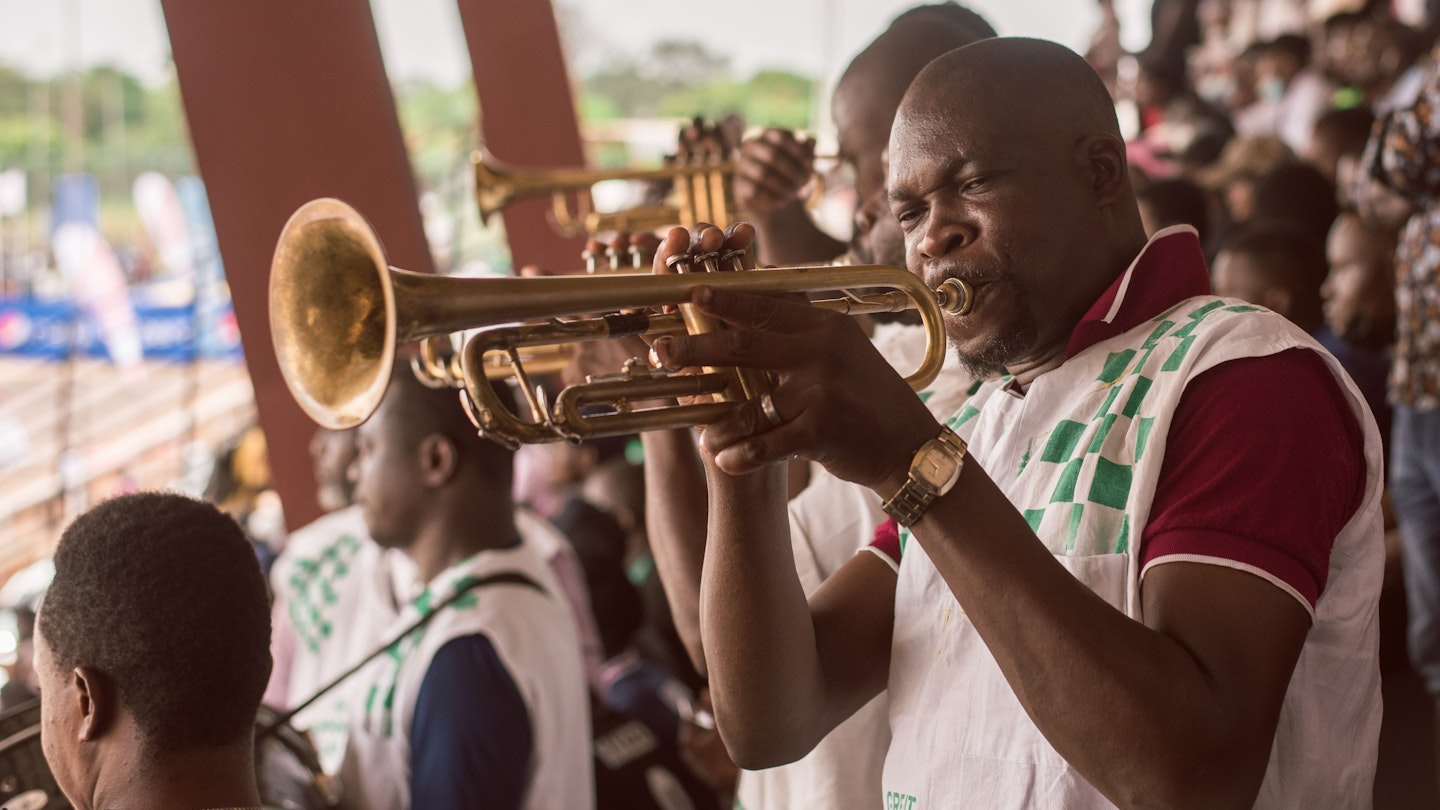There is so much for visitors to Lagos to enjoy – depending on the area, you can tour its heritage sites, some dating back 500 years, or taste the cosmopolitan flavors of Nigeria’s food culture. With a 186km (116-mile) coastline sprinkled with beach resorts, it’s also got no shortage of places to stretch out in the sunshine and forget your worries.
Once you’ve shaken off the stress of home and you’re in the mood for some song and dance, Lagosians will proudly tell you there’s no party like a Lagos party. Whenever you’re planning to visit, these are some of the best neighborhoods to check out when you arrive.
Groove to Afrobeats in Ikeja
Lagos is the birthplace of Afrobeats, a genre of music pioneered in the 1970s by the late Fela Kuti. If you’re a fan, nothing could feel more right than dropping in at his former home, now the Kalakuta Republic Museum in Ikeja.
From the ground floor up, dozens of family portraits line the walls. The tour ends at a terrace bar backdropped by an oil painting of the musician – the default spot for selfies. Order jollof rice, chips, and drinks and listen to a continuous stream of Fela’s music.
If you’d rather bed in at another hotel in the neighborhood, Treasureland Cottage and Presken Hotel are excellent for budget travelers. For a little more luxury, consider the recently opened Watercress Hotels on Oritshe Street, off Awolowo Way.
From there, head to the New Afrika Shrine, built by Fela’s multiple-Grammy-nominee son Femi, who rehearses on Thursday evenings for free and performs to a packed hall during the Shrine’s main show, Sunday Jump.
The Shrine is about the size of a soccer pitch and is open throughout the week. Its core patrons are young Lagosians who come to play snooker, chat over drinks, and watch soccer matches. However, the place is at its liveliest in mid-October during Felabration, the weeklong series of concerts to mark Fela’s birthday, when local and international musicians thrill thousands of fans.
Chill at a Park in Alausa
Still in Ikeja, Alausa is the administrative heart of Lagos, but also one of its more ambient locales. Its wide, tree-lined sidewalks make it one of the easiest neighborhoods to explore on foot.
Stop for a breather at the beautifully landscaped Johnson Jakande Tinubu (JJT) Park, adjoining the Lagos State House of Assembly complex. The park is a great place to spend a refreshing hour or two – it’s quieter on weekdays but packed with picnicking families on weekends, especially on Sundays.
Relax under a shaded tree, or sit in any of the half-dozen gazebos scattered about and watch everyday Lagos drift gently by. While there’s a general atmosphere of calm, familiar sights include students on excursions, celebrants marking their birthdays, couples posing for pre-wedding shoots, and small teams recording low-budget music videos.
Walk Down Memory Lane, from Onikan to Broad Street
As the hub of British colonial rule from the late 19th century until Nigeria’s independence in 1960, the Onikan–Broad Street–Marina district on Lagos Island is perfect for walking tours.
It has some important historic sites from the years of colonial rule, including the National Museum, Tafawa Balewa Square, Holy Cross Cathedral, and Lagos City Hall. Take a break and stop over at Freedom Park, previously a 19th-century prison, now a garden, arts center, gallery, bar, restaurant, and museum. Here, you can choose any part of the leafy surroundings to chill in, enjoying the calming ambiance.
Explore the City’s Brazilian Ties
In addition to the colonial-era buildings on Lagos Island, the character of Lagos’s cityscape is shaped by 19th-century Brazilian-style architecture. This style became prominent after Afro-Brazilians liberated from enslavement sailed back to West Africa en masse from the 1850s onwards.
Onikan House is a fine specimen that has been restored by a private concern. Built in 1940, it offers insights into key events that shaped Lagos, from its early incarnation to its current status as a megacity.
Mingle with Royalty in Downtown Lagos
Lagos may be a cosmopolitan city, but it is also a deeply traditional society. Isale Eko (Downtown Lagos) is where the first royal family was installed in the 1630s. Iga Idugaran, the palace of the king of Lagos, showcases rich architecture and history.
While many areas are now fenced off, there are plenty of historical sites such as palaces, shrines, and ceremonial grounds to explore on foot. Key landmarks worth visiting include the palace of Eletu Odibo and Erelu Square, site of the tomb of Erelu Kuti.
Go Bird-Watching in Lekki
Lekki is an upscale area for many rich and famous Lagosians, featuring trendy restaurants, bars, and galleries. If you’re looking to escape the fast-paced tempo of everyday Lagos, visit the Lekki Conservation Center, a 75-hectare (185-acre) patch of unspoiled mangrove.
The highlight of a visit here is walking above the forest on the 401m (1315-ft) canopy walkway, popular for bird-watching. Attractions also include fish ponds and life-size board games.
Explore Badagry’s History of Enslavement
Badagry is the crown jewel of Lagos tourism, known for its significant heritage sites related to the port for trafficking enslaved people. A typical day tour includes stops at the Badagry Heritage Museum and Vlekete Slave Market.
Locals visit Badagry for its beaches, and it captures the interest of those wanting to connect with ancestral origins. The annual heritage festival in August celebrates various traditions and includes reenactments of historical events.





